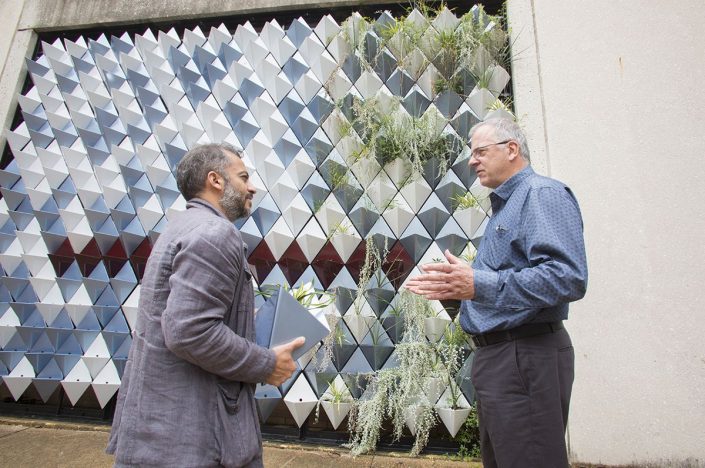Living wall features Texas plants and sheet metal byproducts from autos

Image: College of Architecture
Merging waste metal from the automotive industry, native plants and the ingenuity of Texas A&M design students and professors, a new “Living Wall” adorns the side of Langford Architecture Center’s building B, adding beautification and reducing heat gain effects on the wall and surrounding area.
Only a third of the plants are currently installed due to local sourcing availability; the rest will be added in the spring 2019 semester.
The Living Wall is the brainchild of Ahmed Ali, assistant professor, Department of Architecture, and Bruce Dvorak, associate professor, Department of Landscape Architecture, who worked together to imagine and manufacture an innovative type of “green” wall made of sheet metal byproducts, or offal, with modules individually irrigated by an automatic water-conserving drip system and self-supported on a steel frame.
While “green” walls are gaining popularity in residential and public spaces, most are made from cloth sacks or plastic hydroponic modules, which either require extensive maintenance or encourage mildew. By using offal, hand-cut and shaped with a drainage hole in the bottom at the Texas A&M Automated Fabrication and Design Laboratory by graduate students, the wall is sustainable, long-lasting and economical.
“This is the first living green wall made from sheet metal scrap from the automotive industry,” Ali said. “Our students cut the metal using a computer-controlled water jet, bent the sheets and assembled them with aluminum rivets. It increased their knowledge of the materials and will better inform their design decisions.”
Over the fall 2017, spring 2018 and summer 2018 semesters, students tested dozens of iterations of shapes and designs before finding the unique diamond design. They also tested which colors would best reflect sunlight off the modules.
“The design of the modules is innovative, beautiful and solves a lot of problems with traditional ‘green’ wall systems,” Dvorak said.

